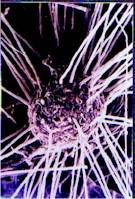ganja: what about the idea (it got lost in the bickering)
Yea sorry about that.
That is an interesting idea. And honesty, I don't' know. What I think might happen if you put it below say 10-15 cm is, if the microbes can process it well at that depth, the plant would use the P. And maybe if there was 'enough' inorganic P available the plant would 'feed' the AM fungus/gi less. But that's just wild speculation....that P should not be available for diffusion except from concentrated areas lower down in the soil. So a handful of bone and blood imitates a dead animal, and the rest of the mix is clean. AM could stay away from the high P area.
One thing to note here, and I think someone already did, which I will expound upon in a quote to their post, is the (old yet) loud debate about allowing raw OM (Organic Matter) like spent brewers grains to decompose within the soil vs on top of soil vs in compost pile. It is actually a VERY interesting debate, I have not weighed in on it at all, there are people who can speak about it much better than I. However, in my studies of the debate, I have come to the pliable conclusion it is best to pre-process the raw OM (in this case a.ka. "feedstock" or "input") by composting. I will post a few really great links to mailing-list discussion on this topic. Ideally, anaerobic processing of the raw OM is best. The reason being with aerobic composting, especially hot composting, total feedstock loss can be about 40-60% of total* by weight. Also, loss of nitrogen, and other elements is greater in aerobic composting vs anaerobic processing:
In the West anaerobic process is known as "ensiling" (verb), or "ensiled", and finally "silage". But we (and the East) know it as the "bokashi" process, that of fermentation. Both use Lactic Acid Bacteria (LAB) to ferment the OM below pH ~4.0. Then the OM is "stable" and called "silage" or "bokashi". The main reason for this process is the total OM lost is very little. And, the amount of initial nutrients lost, especially nitrogen loss (via "ammonification", the "volitization" of ammonia) is greatly reduced.
I for one prefer hot composting using my adapted/updated version of "Controlled Microbial Composting", not only for the general benefits, but for the increased humification and nutrient content. Not to mention the decrease in the pollution of the Earths environment through less nutrient loss. Or the increase in the Earths environment through more Co2 reclamation from the atmosphere
On reason I LOVE reading about the process of "ensiling": IMO it is a much more studied (at least in English) and well defined, thus more effective version of the bokashi process. And the ensiling process uses indigenous LAB, along with molasses and in many cases, wheat bran. The biggest differences between the two seem to be: a) Expense, ensiling uses free LAB, not unnecessary EM mother culture, and/or AEM, and b) stresses the proper moisture content (50-60%; 50-55% is ideal). If anyone is interested I have a bunch of great 'regular guy' great links and lots of journal articles too.
*I find that my compost piles loose about 40-50% of their starting "wet weight" (ie. total weight in pounds) at 50-55% moisture content. I make sure to keep the same moisture content throughout the entire composting process (which is about 4-6 weeks for me). FWIW, in composting the rule is to always speak of moisture content as "wet weight", or "as is". It just means we list the % which is wet, not % which is dry. And FWIW, the unit of 'wet weight' measure is called "gravimetric water content".
No I would not assume so, but I have not read anything to that effect. What I have read is the greater the available P within the rhizosphere, or that is otherwise immediately available to the roots, the less the plant will depend upon AM fungi for P (in most cases), and thus the plant will 'feed' the AM fungi less. As a direct result of being 'feed' less the AM fungi can become less vigorous and prolific. The first paper I uploaded speaks of this phenomenon.Speaking of which - and bacterial death leads to available P, in the for of ATP. Is this to say that microbial life must recede for AM to proliferate?
Yes. Did you see the pic I posted on the second page? The issue is if it's AM fungi or not. If you used dormant (ie. freeze dried) spores I have doubts it is AM fungi. But, I could be wrong. I don't want to take a side right now. But if you added 'a good amount' of bone meal that further influences my doubts...And can you confirm that MA (just kidding!) are visible when the root ball is well colonized? If so, I have gotten them within 4 weeks in soil amended with bone meal. If not, I'll just keep using biotone for all the other goodies.
All the best


 kind regards from guineapig
kind regards from guineapig 
